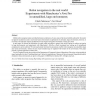Free Online Productivity Tools
i2Speak
i2Symbol
i2OCR
iTex2Img
iWeb2Print
iWeb2Shot
i2Type
iPdf2Split
iPdf2Merge
i2Bopomofo
i2Arabic
i2Style
i2Image
i2PDF
iLatex2Rtf
Sci2ools
RAS
2000
2000
Robot navigation in the real world: : Experiments with Manchester's FortyTwo in unmodified, large environments
Mobile robot navigation under controlled laboratory conditions is, by now, state of the art and reliably achievable. To transfer navigation mechanisms used in such small-scale environments to applications in untreated, large environments, however, is not trivial, and typically requires modifications to the original navigation mechanism: scaling up is hard. In this paper, we discuss the difficulties of mobile robot navigation in general, the various options to achieve navigation in large environments, and experiments with Manchester's FortyTwo, which investigate how scaling up of navigational competencies can be achieved. We were particularly interested in autonomous mobile robot navigation in unmodified, large and varied environments, without the aid of pre-installed maps or supplied CAD models of the environment. This paper presents a general approach to achieve this. FortyTwo regularly travels the corridors of the Department of Computer Science at Manchester University, using t...
| Added | 19 Dec 2010 |
| Updated | 19 Dec 2010 |
| Type | Journal |
| Year | 2000 |
| Where | RAS |
| Authors | Ulrich Nehmzow, Carl Owen |
Comments (0)

